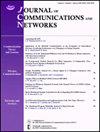基于高效节能rl的灾区空中网络部署试验台
IF 2.9
3区 计算机科学
Q2 COMPUTER SCIENCE, INFORMATION SYSTEMS
引用次数: 2
摘要
5G及以上无线设备的快速部署实现了互联世界。然而,灾难发生后,需求立即增加,网络基础设施暂时瘫痪。在灾难期间,信息的持续流动对于协调救援行动和确定幸存者至关重要。为灾区用户建立的通信基础设施应满足快速部署、扩大覆盖范围和可用性的要求。无人机为快速部署提供了一种潜在的解决方案,因为它们在灾难期间不受交通堵塞和道路物理损坏的影响。此外,自组织WiFi通信允许在清晰信道内生成广播域,这简化了一对多通信。此外,使用强化学习(RL)有助于降低空中网络部署的NP难题的计算成本并提高其准确性。为此,本文提出了一种新的飞行WiFi自组织网络管理模型。该模型利用深度Q学习来保持服务质量(QoS),增加用户设备(UE)的覆盖范围,并优化功率效率。此外,还在伊斯坦布尔技术大学(ITU)校园部署了一个试验台,用于培训开发的模型。使用测试台的模型的训练结果累积了超过90%的数据包传输率作为QoS,流表中用户的覆盖率超过97%,平均功耗为0.28KJ/Bit。本文章由计算机程序翻译,如有差异,请以英文原文为准。
Energy-efficient RL-based aerial network deployment testbed for disaster areas
Rapid deployment of wireless devices with 5G and beyond enabled a connected world. However, an immediate demand increase right after a disaster paralyzes network infrastructure temporarily. The continuous flow of information is crucial during disaster times to coordinate rescue operations and identify the survivors. Communication infrastructures built for users of disaster areas should satisfy rapid deployment, increased coverage, and availability. Unmanned air vehicles (UAV) provide a potential solution for rapid deployment as they are not affected by traffic jams and physical road damage during a disaster. In addition, ad-hoc WiFi communication allows the generation of broadcast domains within a clear channel which eases one-to-many communications. Moreover, using reinforcement learning (RL) helps reduce the computational cost and increases the accuracy of the NP-hard problem of aerial network deployment. To this end, a novel flying WiFi ad-hoc network management model is proposed in this paper. The model utilizes deep-Q-learning to maintain quality-of-service (QoS), increase user equipment (UE) coverage, and optimize power efficiency. Furthermore, a testbed is deployed on Istanbul Technical University (ITU) campus to train the developed model. Training results of the model using testbed accumulates over 90% packet delivery ratio as QoS, over 97% coverage for the users in flow tables, and 0.28 KJ/Bit average power consumption.
求助全文
通过发布文献求助,成功后即可免费获取论文全文。
去求助
来源期刊
CiteScore
6.60
自引率
5.60%
发文量
66
审稿时长
14.4 months
期刊介绍:
The JOURNAL OF COMMUNICATIONS AND NETWORKS is published six times per year, and is committed to publishing high-quality papers that advance the state-of-the-art and practical applications of communications and information networks. Theoretical research contributions presenting new techniques, concepts, or analyses, applied contributions reporting on experiences and experiments, and tutorial expositions of permanent reference value are welcome. The subjects covered by this journal include all topics in communication theory and techniques, communication systems, and information networks. COMMUNICATION THEORY AND SYSTEMS WIRELESS COMMUNICATIONS NETWORKS AND SERVICES.

 求助内容:
求助内容: 应助结果提醒方式:
应助结果提醒方式:


